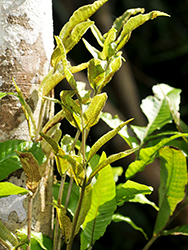e-Flora of Thailand
Volume 3 > Part 3 > Year 1988 > Page 320–321 > Lomariopsidaceae > Bolbitis
11. Bolbitis heteroclita (C.Presl) Ching ex C.Chr.wfo-0001117296
Ind. Fil. Suppl. III.: 48. 1934; Tardieu & C.Chr. in Fl. Indo-Chine 7(2): 434. 1941; Holttum, Rev. Fl. Malaya 2: 462. f. 271. 1954; Dansk Bot. Ark. 20: 30. 1961; 23: 237. 1965; Tagawa & K.Iwats., S.E. Asian Stud. 3(3): 85. 1965; 5: 91. 1967; Hennipman, Leiden Bot. Ser. 2: 221. f. 60. 1977; in Fl. Males. Ser. II. 1: 325. f. 25d, 31a–g. 1978.— Acrostichum heteroclitum C.Presl, Reliq. Haenk. I.: 15. pl. 2. f. 2. 1825.— Leptochilus heteroclitus (C.Presl) C.Chr., Index Filic.: 385. 1906; Bot. Tidsskr. 32: 343. 1916.
Accepted Name : This is currently accepted.
Description : Rhizome long-creeping, scaly; scales nearly black with narrow brown ferrugineous margin, linear, up to 5 by 1 mm. Sterile frond: stipe 10–30 cm long, stramineous; lamina simple or imparipinnate with one or two pairs of lateral pinnae; lateral pinnae oblong, cuneate and shortly stalked at base, caudate at apex, 4–7 cm apart, 7–15 by 3–6 cm, almost entire or irregularly shallowly waved, terminal pinna oblong, or often very long-tailed with narrow linear tails 50–80 cm long, up to 15–20(–30) cm long excluding the tail, 5 cm broad; rachis narrowly winged, glabrescent; costa naked, sometimes viviparous; veins distinct on both surfaces, finely reticulated, without included free veinlets; herbaceous or softly papyraceous, glabrous, deep green, blackish when dry. Fertile frond not seen in Thailand, those of the Philippines plants: stipe nearly the same as or larger than those of sterile ones; lateral pinnae up to 4 pairs, oblong, about 5 by 2.7 cm, apical pinna a little larger than lateral ones, veins reticulate; sporangia spread over the whole undersurface of pinnae.
Thailand : NORTHERN: Chiang Rai (Mae Kok), Chiang Mai (Doi Chiang Dao), Lampang, Phitsanulok (Nakhon Thai, Thung Salaeng Luang); CENTRAL: Nakhon Nayok (Khao Yai); SOUTH-EASTERN: Chon Buri (Si Racha), Chanthaburi (Nam Tok Takhamao, Pong Nam Ron), Trat (Phlio Falls, Huai Raeng); SOUTH-WESTERN: Kanchanaburi (Khao Yai), Prachuap Khiri Khan (Khao Luang); PENINSULAR: Nakhon Si Thammarat (Khao Luang), Trang (Khao Chong).
Distribution : N India, Upper Burma, S & SW China, Taiwan, Ryukyu, Indochina, throughout Malesia (type from Luzon) to New Guinea.
Ecology : On wet ground or on muddy moist rocks usually near streams in dense forests, or rarely epiphytic on base of tree-trunks, at low or medium altitudes.
Vernacular : Kut pao (กูดเป้า), kut hang nok kaling (กูดหางนกกะลิง)(Northern).
Notes: Characteristic of this species in the presence of apical prolonged lobes, though this species does not form colonies like Bolbitis subcordata of Japan. Compared with related species, B. heteroclita seems to prefer very moist habitats and sometimes droops from rocks in the spray of waterfalls. In the epiphytic condition no prolonged terminal pinnae are formed though they become to 30 cm in length.
E-version notes : For more details see Ferns of Thailand, Laos and Cambodia.

